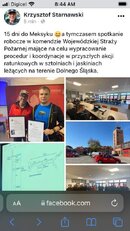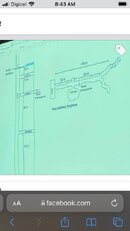News 6
'Divers went under the water four times, looking for three of their friends who had gone missing in the sunken Maria Concordia mine in Sobótka. Krzysztof Starnawski told us how the action was going.
"Underwater, in the corridor where the bodies were located, all the time we were working in a team of two with Witek Hoffmann. He is one of the best cave divers in Poland today. During the last two dives, divers from the fire brigade additionally helped us during the last portion of the dive [the shaft]. This improved the transport of the bodies to the surface"
During the operation, divers made four descents. The first to do a reconnaissance, assess the situation and, above all, the level of water siltation:
"During these operations, we had to replace the guideline, which was probably damaged in this accident. Then we also came across the body of the first diver and right next to him, the second diver."
"During the second dive, we also had to lay down special thick lines, thanks to which the bodies could be transported, because with such zero visibility we had to be sure that we would be able to return safely."
"Although the water in the main shaft of this mine can be very clear, in the side shafts it was muddy and despite the many hours between the accident and our arrival, it practically did not improve much. At the location where the divers had the accident, visibility was very poor. We conducted all activities in a very limited transparency, roughly from one meter to 20 cm. Much of the action was completely in the dark."
"Maria Concordia Mine is one of the most interesting facilities of this type in Europe. Very well prepared and run by speleologists and enthusiasts. It is really perfectly prepared for diving activities, and divers who come there to go underwater can count on professional service."'
'Divers went under the water four times, looking for three of their friends who had gone missing in the sunken Maria Concordia mine in Sobótka. Krzysztof Starnawski told us how the action was going.
"Underwater, in the corridor where the bodies were located, all the time we were working in a team of two with Witek Hoffmann. He is one of the best cave divers in Poland today. During the last two dives, divers from the fire brigade additionally helped us during the last portion of the dive [the shaft]. This improved the transport of the bodies to the surface"
During the operation, divers made four descents. The first to do a reconnaissance, assess the situation and, above all, the level of water siltation:
"During these operations, we had to replace the guideline, which was probably damaged in this accident. Then we also came across the body of the first diver and right next to him, the second diver."
"During the second dive, we also had to lay down special thick lines, thanks to which the bodies could be transported, because with such zero visibility we had to be sure that we would be able to return safely."
"Although the water in the main shaft of this mine can be very clear, in the side shafts it was muddy and despite the many hours between the accident and our arrival, it practically did not improve much. At the location where the divers had the accident, visibility was very poor. We conducted all activities in a very limited transparency, roughly from one meter to 20 cm. Much of the action was completely in the dark."
"Maria Concordia Mine is one of the most interesting facilities of this type in Europe. Very well prepared and run by speleologists and enthusiasts. It is really perfectly prepared for diving activities, and divers who come there to go underwater can count on professional service."'





